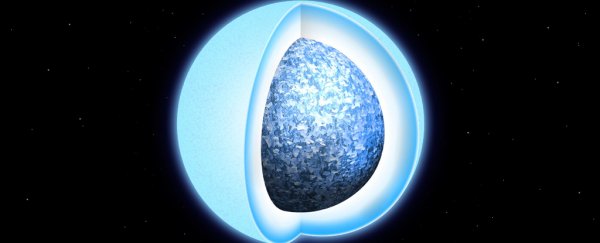Long after fusion has faded and her furnaces have cooled, our Sun's embers will form a giant crystal hanging in the sky – one of countless sprinkled throughout our galaxy.
Astronomers have found evidence that massive white dwarf stars solidify into metallic crystals rather early in retirement. Poetic descriptions aside, it could challenge how we calculate the ages of some of the oldest objects in the Universe.
Using data from the European Space Agency's Gaia satellite, researchers from the UK, Canada, and the US have found support for a 50-year old hypothesis describing the stages many stars go through before ending their lives as crystals.
"This is the first direct evidence that white dwarfs crystallise, or transition from liquid to solid," says physicist Pier-Emmanuel Tremblay from the University of Warwick.
"It was predicted fifty years ago that we should observe a pile-up in the number of white dwarfs at certain luminosities and colours due to crystallisation and only now this has been observed."
While massive stars far bigger than our own go out with a bang, most suns in the Universe are of a rather mediocre mass that sees them age far more quietly.
Once hydrogen has run low, stars like our Sun start to cool down and contract. This provides a brief surge of energy that blows its atmosphere into enormous proportions, sending with it a great deal of its heat.
Meanwhile its core continues to shrink, squeezing helium into even heavier elements like carbon and oxygen.
The end result is a white dwarf – an Earth-sized ball so dense, a tiny 1cm3 portion of its core would weigh around 10 tonnes.
The eventual fate of these luke-warm hearts of dying stars will eventually be a frozen corpse called a black dwarf.
Given how long it's thought to take for white dwarfs to cool, few (if any) should have reached that point yet. Finding one would profoundly change how we thought about the Universe's age.
But just how does a white dwarf shed its heat? The internal mechanics make a big difference to how heat seeps towards the surface, and have long been a subject of debate.
Deep inside the white dwarf its electrons move freely, slipping through a jiggling crowd of carbon and oxygen nuclei and carrying heat slowly towards its more conductive surface.
Theoretically, at around 10 million degrees, there's no longer enough energy to allow the positive nuclei in the core to move out of position. They lock in place, forming a vast crystalline structure that releases a significant amount of energy.
The question is all a matter of timing. In small white dwarfs, crystallisation coincides with a process that links the core with the outer layers, allowing that heat energy to be easily shed. Once connected, the star cools down rather efficiently.
Much heavier stars are more of a mystery. Finding evidence of their own sequence has been difficult, both thanks to the tiny size of white dwarfs in general and the less obvious cooling signature of the more massive varieties.
The researchers collected data on more than 15,000 objects likely to be white dwarfs, all within around 300 light years of Earth. After comparing their masses and ages, they found there were more stars than there should be of a certain brightness and colour.
This pattern lined up neatly with theoretical predictions describing how white dwarfs of a given mass shed their heat, suggesting crystallisation occurs much earlier in white dwarfs with masses that exceed our own Sun's.
"All white dwarfs will crystallise at some point in their evolution, although more massive white dwarfs go through the process sooner," says Tremblay.
"This means that billions of white dwarfs in our galaxy have already completed the process and are essentially crystal spheres in the sky."
Confirming this model has some pretty big implications for the aging of some of the most common objects in the Milky Way.
With crystallisation occurring before white dwarfs can blow off that heat, their cooling process is impeded, slowing down their aging process by up to 2 billion years.
Not only did the researchers find crystallisation sets in early in heavy white dwarfs, considerably more energy than expected was lost when that heat was released.
"We believe this is due to the oxygen crystallising first and then sinking to the core, a process similar to sedimentation on a river bed on Earth," says Tremblay.
To astronomers, this find provides observations that can help confirm how stars like our own Sun change over time, giving us a much better idea of the evolution of our galaxy.
The rest of us can gaze up at the cosmos and appreciate among the blazing furnaces of star dust, there are even more gems than we ever imagined.
This research was published in Nature.
